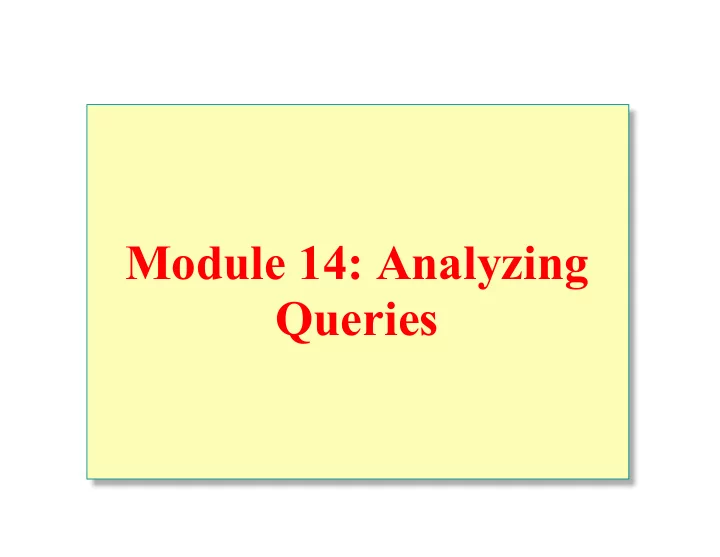

Module 14: Analyzing Queries
Overview Queries That Use the AND Operator the OR Operator Join Operations
Queries That Use the AND Operator Processing the AND Operator Returns rows that meet all conditions for every criterion specified in the WHERE clause Progressively limits the number of rows returned with each additional search condition Can use an index for each search condition of the WHERE clause Indexing Guidelines and Performance Considerations Define an index on one highly selective search criterion Evaluate performance between creating multiple, single- column indexes and creating a composite index
Queries That Use the OR Operator Processing the AND Operator Returns Rows That Meet Any of the Conditions for Every Criterion Specified in the WHERE Clause Progressively Increases the Number of Rows Returned with Each Additional Search Condition Can Use One Index or Different Indexes for Each Part of the OR Operator Always Performs a Table Scan or Clustered Index Scan If One Column Referenced in the OR Operator Does Not Have an Index or If the Index Is Not Useful Can Use Multiple Indexes
Queries That Use Join Operations Selectivity and Density of a JOIN Clause How Joins Are Processed How Nested Loop Joins Are Processed Multimedia: How Joins Are Processed Considerations When Merge Joins Are Used How Hash Joins Are Processed
Selectivity and Density of a JOIN Clause Selectivity of a JOIN Clause Based on index density, if Percentage of Rows Returned statistics are available Based on a number of considerations, if statistics are unavailable Density of a JOIN Clause An index with large number of duplicates has high join density Selectivity A unique index has low join density
How Joins Are Processed USE credit SELECT m.member_no, c.charge_no, c.charge_amt, c.statement_no FROM member AS m INNER JOIN charge AS c ON m.member_no = c.member_no Unique WHERE c.member_no = 5678 nonclustered index Nonclustered index Result member_no charge_no … member member charge charge 5678 30257 member_no … charge_no member_no … 5678 17673 . . . . . . 5678 15259 . . . . 5678 16351 . . 15259 5678 5678 Chen 5678 32778 . . . . 5678 48897 . . . . 5678 60611 . . . . 16351 5678 5678 66794 . . 5678 74396 . . 5678 76840 . . 5678 86173 17673 5678 . . 5678 87902 . . 5678 99607 . . (13 row(s) affected
How Nested Loop Joins Are Processed USE credit SELECT m.member_no, c.charge_no, c.charge_amt, s.statement_no FROM member AS m INNER JOIN charge AS c ON m.member_no = c.member_no INNER JOIN statement AS s ON c.member_no = s.member_no WHERE m.member_no = 5678 member member statement statement charge charge member_no … statement_no member_no … charge_no member_no . . . . . . . . . . . . . . . . . . . . . 15259 5678 5678 Chen 5678 5678 . . . . . 15678 5678 . . . . . . . . . . . . . . . 16351 5678 . . . . . . . . . 1 1 Retrieves qualifying rows 17673 5678 . . from both tables and joins them . . . . 2 2 Joins the results with the qualifying rows of the charge table
Multimedia: How Merge Joins Are Processed
Considerations When Merge Joins Are Used Requires That Joined Columns Are Sorted Evaluates Sorted Values Uses an existing index tree Leverages sort operations Performs its own sort operation Performance Considerations Usually default USE credit SELECT m.lastname, p.payment_amt FROM member AS m INNER JOIN payment AS p ON m.member_no = p.member_no WHERE p.payment_amt < 7000 AND m.firstname < 'Jak'
Recommended Practices Define an Index on a Highly Selective Column Ensure That Useful Indexes Exist for All Columns Referenced in the OR Operator Minimize the Use of Hash Joins
Review Queries That Use the AND Operator the OR Operator Join Operations
Recommend
More recommend